
Showdown on West Coast Docks: The Battle of Longview
(November 2011).
click on photo for article
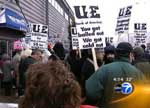
Chicago Plant Occupation Electrifies Labor
(December 2008).
click on photo for article

May Day Strike Against the War Shuts Down
U.S. West Coast Ports
(May 2008)
click on photo for article

June 2021
For
Workers Control of Safety – End Poverty Wages –
Expropriate For-Profit Chains
Nursing Home COVID Horror Show:
Health Care Workers Held Hostage
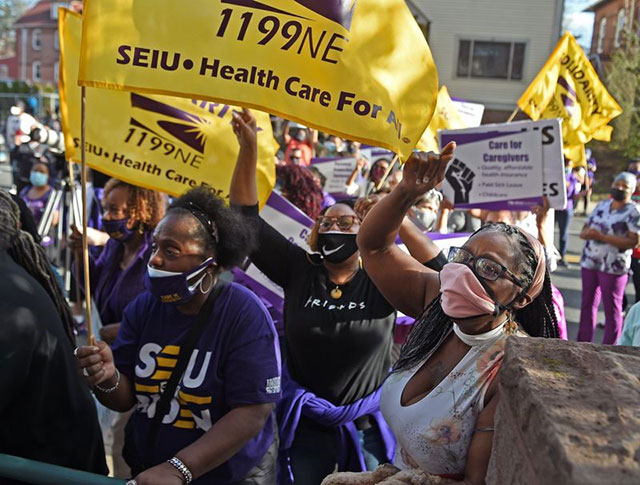
Connecticut nursing home workers organized by SEIU District 1199NE demonstrate outside Department of Health in Hartford, April 8, demanding Long-Term Care Workers Bill of Rights including $20/hr. minimum wage, affordable health care. (Photo: Brad Horrigan / Hartford Courant)
JUNE 7 – For the last three weeks, some 6,100 unionized healthcare workers in Connecticut nursing homes and group homes have been preparing to strike. The main demands of Service Employees International Union (SEIU) District 1199NE are for raising the horrendously low pay for their dangerous work to $20 an hour; for affordable health insurance, paid sick leave and childcare; and for increasing Medicaid funding by taxing the rich. As the initial nursing home strike deadline on May 14 loomed, Democratic governor Ned Lamont outrageously called up the National Guard to act as strikebreakers, to move patients out of struck facilities. Meanwhile, the long-term care facilities sought to contract “replacement workers” – i.e., scabs. Last-minute deals with the governor averted that walkout and a subsequent strike deadline for group homes on June 4. But as of this writing, the facility owners have yet to sign on the dotted line.
So far, details of the tentative agreements are sparse. Newspaper headlines declared that “Nursing home workers will earn at least $20 per hour” while articles declared that the deal “lifts the wages of certified nursing assistants to $20 per hour,” and that “Licensed practical nurses would earn an hourly minimum of $30” (Hartford Courant, 14 May). But that does not square with the reference to a 4.5% raise in 2022, a 6.2% raise the next year and no raises in the following two years, which would only bring pay for CNAs up from $16.25 to $18 by 2025. Moreover, 1199NE president Rob Baril later said that the nursing home deal would create “a pathway to $20 an hour minimum,” and that a June 3 deal for group homes achieved “substantial progress toward our goals for a $20 minimum wage,” and other benefits. If the advertised $20/hr. minimum was not achieved, this amounts to a sellout of the union membership.
Even $20 per hour is a poverty wage, and nothing has been specified about health insurance, which even at that pay rate would certainly not be affordable. Anything that even purports to be a “living wage” in Connecticut would have to at least double nursing home workers’ wages and provide fully paid quality health care for workers and their families with no deductibles, “co-pays” or other scams. Residential healthcare workers are in an unusually strong position right now to fight for a fundamental change in their intolerable situation. As billions of dollars are being lavished on bailing out whole industries, the horrors of the pandemic, as death stalked the corridors of nursing homes, are fresh in everyone’s mind. A militant strike could win. That such a struggle is not taking place today is an indictment of the labor bureaucracy that plays by the bosses’ rules and chains workers to the capitalist Democratic Party.
Almost one-third of all deaths from COVID-19 over the last year were of residents in long-term care facilities. At least 1,800 healthcare workers in these facilities died.1 This was murder, a monstrous crime fueled by the profit system that discards those it cannot exploit profitably, warehousing seniors in jam-packed quarters with woefully inadequate staffing, and then infecting them with a deadly disease by bringing back COVID patients in order to save the hospitals from collapse. The entire labor movement and its allies, including students and defenders of black and immigrant rights, in Connecticut and elsewhere, should come to the aid of those who toil in this dangerous and sleazy industry. The cause of these terribly overworked and underpaid workers – 92% of them women, a majority black, Latina and Asian, many of them immigrants – is a fight for all working people.
Nursing Homes and Capitalism: “Neglect for Profit”
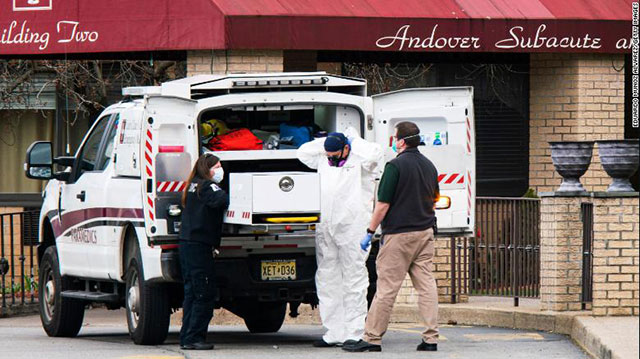
Ambulance workers prepare to transport body at Andover Subacute nursing home where 84 died. (Photo: Eduardo Munoz Alvarez / Getty Images)
Long-term care (LTC) workers in Connecticut, both in nursing homes and group homes for adults and youths with developmental difficulties, include registered nurses, licensed practical nurses, certified nursing assistants and staff. They have been working right through the COVID-19 pandemic in some of the most deadly conditions in the U.S. Since March, unionized workers have been on the job without a contract. Most of the staff have been struggling to keep above water on poverty wages of $12 to $15 an hour and no or unaffordable health insurance. They faced a massive shortage of personal protective equipment (PPE) such as gloves, masks and gowns that workers had to either reuse and/or share among each other. Many CNAs have overwhelming workloads of 15 or more residents each, which includes waking, dressing, toileting and feeding residents, and completing piles of paperwork. Staff shortages are rampant.
Nationally, 70% of the U.S.’ 15,400 nursing homes are operated by for-profit companies; in Connecticut the rate is even higher, with 83% for-profit and only 17% non-profits, with over half part of a corporate chain. Yet 85% of their financing comes from government Medicaid and Medicare programs. The nursing home industry has long been notorious for shortchanging patient care and worker pay, a “business model” of “neglect for profit.” Early in the pandemic, when outside the New York City epicenter the large majority of COVID deaths were in nursing homes, the New York Times (22 April) called them “deadly petri dishes for the worst pandemic in generations.” Many of those deaths were profit-driven. Nearly half of residents of for-profit homes lived in facilities with substandard staffing levels, compared to less than a quarter in government or non-profit facilities. And as data from Connecticut shows (see below), homes with staff shortages had almost five times as many deaths as those without staff shortages.
Recently, many homes have been snapped up by private equity firms (whose finances are not public) which have used them as a cash cow, to be milked for every last dollar. As thousands died weekly last year, a New York Times (25 April 2020) article, “Push for Profits Left Nursing Homes Struggling to Provide Care,” reported: “Private equity firms and other investors first gravitated to nursing homes more than a decade ago, betting that aging baby boomers would create demand irrespective of economic cycles and counting on a steady stream of Medicare and Medicaid reimbursements.” A study published last year of nursing homes nationwide, including 1,674 taken over by private equity firms with “high-powered for-profit incentives,” found that due to staffing cutbacks “private equity ownership increases short-term mortality by 10%, which implies about 21,000 lives lost due to private equity ownership” over the period of 2000-2017.2
There are endless horror stories of the ravages of COVID in nursing homes and how this is related to the ownership of the industry. There was the case of the Andover Subacute & Rehabilitation complex in Sussex County, New Jersey, where an anonymous tip led to the discovery of 17 bodies crammed into a tiny on-site morgue in April 2020; the death toll later rose to 84. The complex is owned by nursing home slumlord Chaim Scheinbaum, whose Alliance Health Care chain also owns three other facilities where according to Times data there were an additional 90 deaths from COVID-19. But Alliance only leases the Andover buildings from a Chicago-area investor, William Rothner, who has a stake in more than 60 nursing homes, and whose companies charge millions in rent in addition to supplying ventilators,
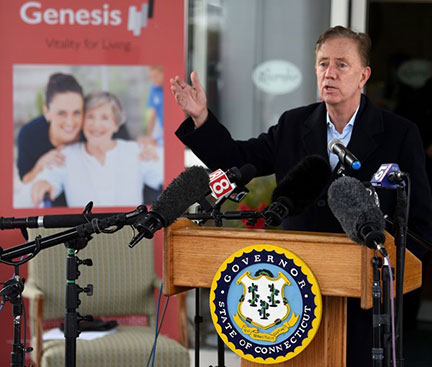 Connecticut governor Ned
Lamont announces extension of state of emergency at
Genesis Healthcare facility, 20 April 2020. Genesis is a
prime example of private equity milking long-term care
facilities for profits while residents die.
Connecticut governor Ned
Lamont announces extension of state of emergency at
Genesis Healthcare facility, 20 April 2020. Genesis is a
prime example of private equity milking long-term care
facilities for profits while residents die. (Photo: Brad Horrigan / Hartford Courant)
Another of the LTC chains is Genesis Healthcare, the largest nursing home operator in the U.S. with more than 357 homes, that is also No. 1 in Connecticut, where it has 19 facilities. Genesis was bought out in 2007 by private equity firms led by Formation Capital in Atlanta, which loaded it up with debt. When it returned to public markets in 2014, Genesis was “paying more than $750 million a year on interest, rent, and transaction fees related to the constant cash-juggling” to keep the company afloat.3 Now the Welltower real estate trust unloaded Genesis, whose share price has plummeted, in exchange for cash investments of $86 million to pay off Welltower. The new private equity operation, ReGen Healthcare, is led by one Joel Landau, infamous for buying up Rivington House and another NYC nursing home, CABS, kicking out elderly tenants and reselling the property to a luxury condo developer for a $72 million profit.
Such financial skullduggery makes for scandal headlines, but the reasons for the nursing homes’ COVID disaster go much deeper than asset stripping by private equity speculators and service cuts by for-profit chains. Overall, 31% of all COVID deaths in the United States are from long-term care facilities, although they account for only 4% of cases nationwide – meaning those nursing home residents who contracted the disease were eight times more likely to die. Over 184,000 people lost their lives, or 12% of the 1.5 million residents in these homes. In Connecticut, the percentage of COVID deaths accounted for by residents of LTC homes is even higher: 4,361 died of the disease, amounting to 53% of total statewide deaths.4 Both for-profit companies and non-profit social service agencies are guilty of negligence and mismanagement with the complicity of the bourgeois state, which foots most of the bills. They all uphold the interests of capital, for which residential-care residents are only dollar signs.
Health Care Workers: Hailed as Heroes, Abandoned on the Front Lines
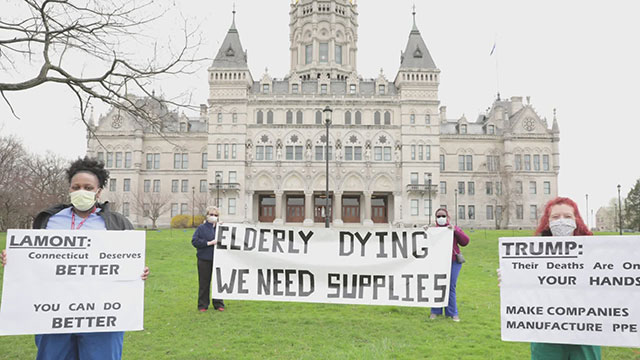
Long-term care workers protest outside Connecticut state capitol in Hartford, April 2020, demanding protective gear as patients were dying by the thousands. (Photo: fox61.com)
Although the scandalous conditions that have turned many nursing homes into death traps are national in scope, this crisis has been more closely investigated in Connecticut with at least two major studies of deaths in long-term care facilities: A Study of the COVID-19 Outbreak and Response in Connecticut Long-Term Care Facilities (September 2020) by the public policy research company Mathematica, advised by the University of Connecticut Center on Aging, commissioned by the state government; and “We Were Abandoned”: How Connecticut Failed Nursing Home Workers and Residents During the COVID-19 Pandemic (May 2020), by the Worker and Immigrant Rights Advocacy Clinic at Yale Law School, for SEIU District 1199NE. Both studies arrive at a key conclusion: high rates of infection and death were the result of chronically understaffed facilities with “severely underpaid” workers.
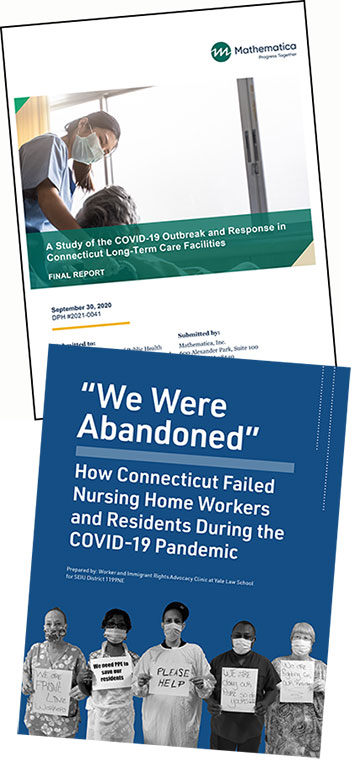
One of the main reasons for the rapid spread of coronavirus infections in nursing homes is that patients were sent back to LTC facilities when discharged from hospitals after being diagnosed with COVID-19. Unlike New York (and other states that copied it), which officially ordered this, there was no such order in Connecticut. Yet it occurred anyway because of financial incentives, as residential care facilities are reimbursed by Medicaid and Medicare at far higher rates for short-term rehabilitation patients coming from hospitals than for long-term residents. While Connecticut readied field hospitals, they were never used, and a couple of COVID-only facilities sat mostly empty. According to the September 2020 Mathematica study, “Early planning and response efforts focused on hospital capacity, with nursing homes viewed primarily as a backstop to alleviate high demand for acute care beds.” I.e., they were dumping grounds.
The high death toll reflects the chaotic conditions in the industry, where many facilities are constantly on the brink of financial ruin, as well as turmoil among public health authorities. On March 5, the day the first COVID case in Connecticut was announced, the deputy commissioner in charge of coronavirus response resigned complaining of racial discrimination. Eight weeks later, the commissioner of the Department of Public Health was fired by Governor Lamont, after being invisible for most of the period. Lamont then essentially privatized the state’s pandemic response, handing planning over to a task force led by the Boston Consulting Group. At the same time, he issued an executive order (as did New York and other states) granting nursing homes “immunity from civil liability even when facilities are ‘unable to provide the level or manner of care that otherwise would have been required in the absence of the COVID-19 pandemic.”
But the crucial element was the nursing and group home workers themselves, overworked and underpaid on the front lines of the battle against the coronavirus. The Yale study found that there was “a significant association between staff shortages and risk of COVID-19 infection and deaths among residents” because “staffing levels correspond directly to quality of care.” Based on data reported to the federal Centers for Medicare and Medicaid Services (CMS), the study showed that facilities “with at least one staff shortage reached a peak of resident deaths over 4 times higher than homes without any reported shortage.” At the peak of the winter 2020-21 second wave, facilities with staff shortages had five times as many cases as those with normal staffing levels. Workers were overwhelmed and there weren’t enough to work the units.
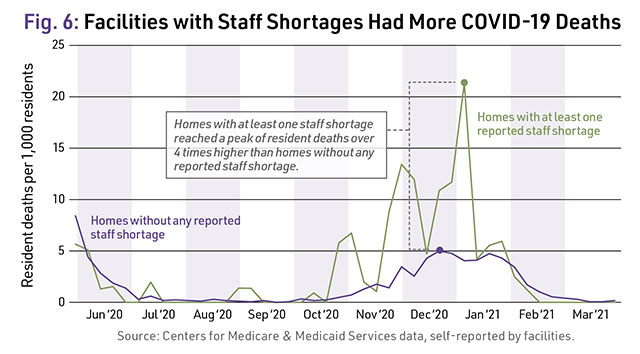
At height of COVID second wave, Connecticut nursing homes with staff shortages had vastly higher mortality rates than those with no shortage. (Graphic from report by Yale Law School Worker and Immigrant Rights Advocacy Clinic)
One nurse described workloads of up to 14 residents at a time, “which is really difficult because you have to get them up, get them dressed, toilet them, exercise them, feed them lunch, toilet them again after lunch, put them down again, and then you have your paperwork.” The understaffing was chronic, both before and during the COVID crisis. The horror of the situation was reflected in the candid observation of another worker, “In all honesty, the only time staffing wasn’t horrible was during the pandemic … only because half our people died. That’s the only reason staffing was halfway okay. Half of the residents passed away due to COVID-19.” Nationally, one in ten LTC residents who fell ill with the disease died; in the hardest-hit facilities in Connecticut (Riverside, 60 dead; Shady Knoll, 55 dead; Arden House, 54) it was one in three.
The workers themselves were also hard-hit. According to data submitted to the Centers for Medicare and Medicaid Services (CMS), at least 3,400 workers in Connecticut LTC facilities either tested positive or were assumed to have contracted COVID-19. District 1199NE reports that up to 4,000 of its 7,000 members working in health care were infected with the coronavirus or had COVID-like symptoms. According to the Yale study, as workers had no sick leave, they often “downplay[ed] their own symptoms” because calling out was considered “abandonment” by administrators. When ill employees were able to take off, they were allotted only seven days so that when they returned to work, there was a more than likely chance they were still contagious. Staff testing was either non-existent, unreliable or results were delayed, and often “administrators withheld information about positive [resident] tests in a facility.”
For a long time, there was no data at all on the number of infections and deaths from COVID among long-term care workers because they weren’t required to be tested and no count was kept of those who were, even though known COVID cases had to be reported to the DPH. Financial incentives were offered to keep workers on the clock, including “bonuses, hazard pay, and providing meals during shifts,” but according to the Mathematica study “nursing homes tied many of the financial incentives to on-time arrival. Staff expressed frustrations with these requirements because public transportation was limited at the height of the outbreak, and many staff had caregiving responsibilities at home that might have occasionally made them a few minutes late to work. Staff also reported bonuses or hazard pay were available only during a short period (even though the pandemic lasted for months).”
Grotesquely, some administrators (and the bourgeois press) blamed staff working at more than one location for the spread of the virus. As one certified nursing assistant (CNA) nurse who worked 32 hours a week at one facility and 24 hours a week at another told the Yale researchers, “If we have a decent paycheck, then we wouldn’t have to do that.” With a median hourly wage of $16.19, certified nursing assistants have no choice but to work more than one job to keep a roof over their head and food on the table for their families. But instead of doubling or tripling wages, administrators tried to limit the number of shifts, making the situation worse. The reality is that the close-contact work provided by CNAs and other staff was key to keeping residents alive, even as it endangered the workers. CNAs “provide 80% to 90% of direct care” in nursing homes, yet the pay is so low and pressures so great that there is a 50% annual turnover rate.
When it came to PPE, workers were often left without. Staff had to share gowns when entering COVID-19 positive resident rooms and were told to “continue wearing single-use protective Tyvek suits for ‘numerous days’,” even at facilities that had ample supplies. Some had to wear garbage bags, held together with duct tape, which caused a stir in the press. Yet DPH leaders grotesquely claimed this was “by choice”! Single-use disposable gloves were routinely cleaned with hand sanitizer for reuse and N95 masks were not properly fitted. One certified nursing assistant was told at the start of the pandemic to remove her disposable mask because it was “sending the wrong message,” and administrators “threatened to write people up if they refused to remove their masks.” In addition, workers reported that administrators “hid the reality of the employees’ appalling working conditions from the government during inspections.”
Mounting infection control violations flew under the radar with only 34 citations for COVID-related incidents in Connecticut from March 2020 to February 2021. And although fines could range up to $10,000 per incident, the average was $2,885, a slap on the wrist. At Riverside Health and Rehabilitation, where 80 residents died from COVID-19, there were zero fines for COVID-related violations. Moreover, in July-August 2020, after months of putting their lives on the line providing direct, in-person, close-up care to one of the most vulnerable populations, 2,000 “essential” workers were rewarded by being laid off or their hours cut by half or more. Why? Because the huge number of residents’ deaths meant a reduced need for labor!
“As nursing home residents die and the facilities see far fewer short-term residents… homes are left with more empty beds. Weakened by revenue loss and added expenses associated with the pandemic, nursing homes in Connecticut are now resorting to widespread layoffs and reductions in employee hours”
–“Hundreds of nursing home workers are laid off as financial crisis hits the facilities,” CT Mirror, 31 August 2020
So whether facilities are private or “public,” for-profit or non-profit, amid a deadly public health crisis vital decisions are made according to financial criteria not patient need. Capital rules.
Capitalist Control of Health Care Is a Disaster
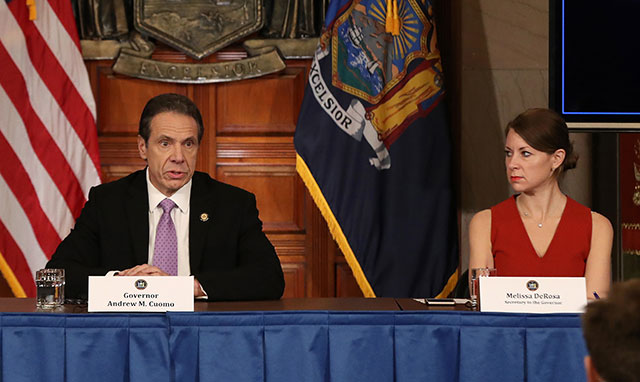
NY governor Andrew Cuomo and top aide Melissa DeRosa at COVID briefing, 21 March 2020. Four days later he issued executive order sending COVID-positive patients to nursing homes. (Photo: Bennett Raglin/Getty Images)
In New York this January, Governor Andrew Cuomo’s nursing home scandal epitomized the lengths the capitalist order will go to save their own political hides: send nursing home residents to their deathbeds and cover it up. Cuomo came under fire issuing his March 2020 directive ordering nursing homes to accept COVID-19 positive patients unless they declared they were unprepared to handle them. Up to late January 2021, the Cuomo administration was reporting 8,711 nursing home deaths. But then NY attorney general Letitia James issued a report saying this undercounted nursing home deaths “by approximately 50 percent,” mainly by not counting those who died in hospitals. NY health commissioner Howard Zucker then discovered another 4,000 nursing home dead. (The toll has since climbed to over 15,000.) Cuomo replied, “But who cares = 33 [percent], 28 [percent] – died in the hospital, died in a nursing home? They died.”5
Well, it turned out quite a few people cared, including Cuomo’s numerous political enemies. Last July, Zucker used the low count to blame “thousands” of nursing workers for infecting the patients. Cuomo’s next line of defense was to say that the nursing homes said they were prepared to accept the patients. Yet on 8 April 2020, when the director of the Cobble Hill Health Center in Brooklyn emailed the state Department of Health saying the facility had “over 50 symptomatic patients scattered through the building and almost no gowns,” and a day later asked to transfer patients to the hospital at the Javits Center or the U.S. Navy hospital ship, he got a reply with an attachment on how to preserve PPE and was told that the empty Center and ship were only for hospital overflow patients. Two weeks later, 55 Cobble Hill residents were dead of COVID.6
As pressure mounted on Cuomo to explain why the death totals were undercounted, his top aide, Melissa DeRosa, let the cat out of the bag during a private videoconference call with state Democratic leaders. She apologized on behalf of the administration for “inconveniencing” the legislators, saying that the actual numbers were purposefully obscured to keep Donald Trump from “tweeting that we killed everyone in nursing homes,” because the real death toll “would be used against us.”7 Cuomo evidently figured the top Democrats would keep this hush hush, but some of them had their own bone to pick with the high-handed governor. When it was later revealed that, at the same time that his administration was covering up the nursing home death toll, he had also gotten a book deal for over $5 million for a vanity tome on how great he supposedly did in fighting the coronavirus, it only added fuel to the get-Cuomo bonfire.
Cuomo’s fallback was that his order was in line with guidance from the federal Centers for Disease Control and Prevention (CDC). That much is true, but all it meant was that around the country Democratic governors were working in tandem with Republican Trump’s CDC to push “stabilized” COVID patients out of hospitals. As the bourgeois media were lauding Cuomo’s handling of the coronavirus pandemic, we pointed out that China, with its collectivized economy, managed to build emergency hospitals in days and with rigorous quarantines corralled the virus, while in New York “the way … medical authorities managed to avoid a complete breakdown of the hospital system was by sending large numbers of coronavirus-positive people back out into the community instead of isolating and hospitalizing them!” (“A Tale of Two Cities: Wuhan – New York,” The Internationalist No. 59, March-April 2020).
For Workers Control of Safety – Fight for Socialized Medicine
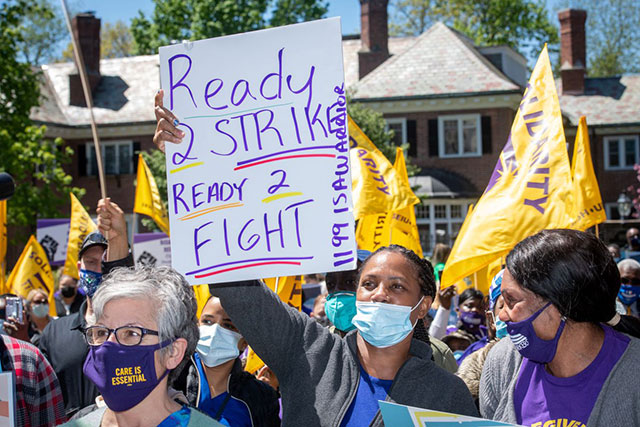
Connecticut nursing home workers ready to strike. The overwhelming majority of long-term care workers are women, most black, Latina and Asian. (Photo: SEIU District 1199)
While coronavirus-denier Trump was cynically counting on “herd immunity” to set in after enough COVID deaths, the Democrats only sought to “flatten the curve” of infections, to spread them out so that the hospitals (which had been downsized and closed in the name of efficiency) weren’t overwhelmed. Both figured on large numbers of deaths while awaiting a vaccine. Neither seriously tried to stop the spread of the virus. The COVID disaster was a bipartisan affair and an indictment of the entire capitalist medical system. The liberal/reformist elixir of “single-payer” medical insurance would not have changed the outcome. As Marxists and communists, the Internationalist Group calls for socialized medicine to provide high quality free health care for all. That will require breaking with the Democratic Party and all capitalist parties and politicians, and building a revolutionary workers party to fight for a workers government.
This is also the case when it comes to care for the elderly. Under the production-for-profit system, those who are no longer of an age where their labor can produce value and be exploited by the owners of capital are simply a burden, a “social overhead” cost to be minimized. Those whose families can afford it are housed in luxurious “assisted living” communities, while those that can’t depend on relatives or go onto Medicaid. But to get on Medicaid their assets can be no more than $2,000, so if they can’t deed over their houses to their kids, the nursing homes will quickly eat up their meagre savings by charging thousands of dollars a month. Thus these centers care only for poor and working-class or pauperized middle-class residents. There, depending on the owners, they are isolated from society, get rationed care and often (particularly in private equity owned centers) are drugged up on anti-psychotic medications to keep them “manageable.”
It doesn’t have to be this way, of course. Bills such as SB 1030 to require greatly increased nursing and attendant care hours per resident (and maintaining a sufficient stockpile of PPE) should be passed, and fully funded at top union wages as this would require hiring thousands more workers. The capitalist predators who feed on the elderly and have been buying up long-term care homes in order to get on the government gravy train like defense contractors are parasites – they should be driven out. Revolutionary socialists would call for expropriation without compensation of the LTC chains and slumlords. But control of nursing homes by the same capitalist government which has been shortchanging Medicaid for decades is no solution. The Internationalist Group calls for control of scheduling, hiring and safety in every facility by union-led workers committees independent of management.
 Under capitalism, where health care is
driven by profit, innovative care for the aging, such as
in the garden city of Tapiola, Fnlnand (left), where older
people were not segregated off but integrated with younger
families, is destined to remain experimental and few in
number. (Photo: Pinterest)
Under capitalism, where health care is
driven by profit, innovative care for the aging, such as
in the garden city of Tapiola, Fnlnand (left), where older
people were not segregated off but integrated with younger
families, is destined to remain experimental and few in
number. (Photo: Pinterest)Over the decades, social theorists have developed various models for a range of different settings providing services and needed medical care for older people so that they can still be part of a multifaceted community rather than being segregated off. In Scandinavian countries, most senior care is through municipal services in their own homes. There have been “garden communities” such as Tapiola in Finland, sponsored by the trade unions, with mixed housing, including in high-rise apartments with older residents on the ground floor for easier access, and so they are not surrounded only by older people. But under capitalism, such models will only be experimental and few in number, for a simple reason: they are not profitable, any more than decent housing or health care for working people is.
Whether it is taking the necessary measures to keep a deadly disease from unleashing a holocaust, as has happened with the COVID-19 pandemic, or providing humane care for those who require special services, this is only possible in a system in which production is to fill social needs rather than to produce private profits. Then necessary measures to deal with a public health emergency will not lead to economic catastrophe. And in that setting, the socialized services and care needed by the elderly will not be a burden on society but an opportunity for creative efforts to enable all to enjoy the fruits of collective labor according to their needs. It will take a socialist revolution to get there, and that is the task the Internationalist Group has undertaken. ■
Understaffing,
Overwork, Super-Exploitation and Abuse –
It All Goes Together
The Pandemic in Connecticut Group
Homes:
Not Just the Virus, It’s the Capitalist System
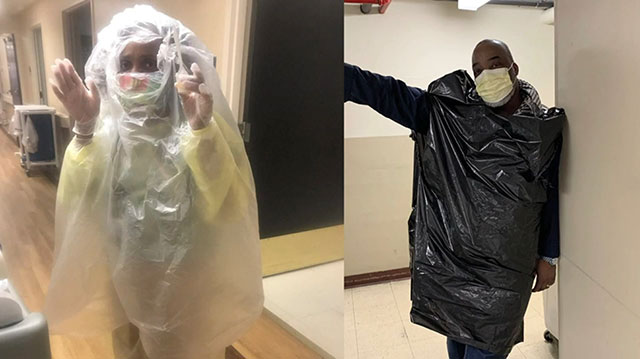
Connecticut long-term care workers had to use garbage bags as gowns for lack of adequate PPE.
(Photo: SEIU District 1199NE)
By Nathan
The COVID-19 pandemic has been a devastating event, killing millions worldwide, over half a million in the United States alone. But it is not simply the coronavirus itself which has wrought these horrific effects upon the world. The chaotic and criminal mismanagement of the pandemic by the ruling class has hugely multiplied the damage, from haphazard lockdowns in the capitalist countries, to misinformation based on science denial regarding safety precautions, to exclusion of millions of immigrants and others from the emergency aid dished out to those rendered jobless by the layoffs. The consequences of the pandemic have rendered naked the destructive nature of a society whose rulers are driven by the profit motive rather than fulfilling human needs.
As a worker in the healthcare industry, I witnessed the effects of this sinister system first-hand. I worked in a unionized long-term care facility in Connecticut. These facilities serve individuals who require support in their activities of daily living, from showering, to toileting, dressing themselves, and so on. Most of the individuals living in these homes have multiple, co-morbid disorders and disabilities, many of which effect either their respiratory or immune systems, and in many cases both. Therefore, I and my fellow workers immediately understood that our clients, whose lives and well-being we cared for deeply, were at an extremely high risk for not only contracting this virus, but dying from it.
This understanding, intuitive to us workers, was not at all apparent to the management of the company, which was criminally slow to introduce safety precautions, such as temperature checks of all staff coming on shift, mandatory mask-wearing in all the homes, thoroughly cleaning the house several times a day, or even ending community outings for the disabled individuals that we served. When they did introduce these life-saving measures, they did little to accommodate workers who did contract the virus and thereby could not work, as doing so would put the lives of our clients in mortal danger.
Thus the company required workers to use our own paid-time-off (PTO) if we caught COVID19. This meant that any of us taking the necessary action of quarantining ourselves to protect others would have to pay for it ourselves. The union bureaucracy made a half-hearted attempt to force the companies to pay workers’ sick from COVID-19 separately from their normal PTO. But this failed miserably, despite strong rank and file support from the workers in the union. It failed because it wasn’t backed up with action.
The dangers of having workers who cannot afford to call in sick if they have COVID-19 are not hypothetical. One of the houses run by the company I worked for had four individuals living in it before one of them became infected with the virus. Two weeks later, all but one of the people living in that home had died of the disease. When the news of this tragedy reached me, I was at first horrified, but that horror turned to anger. Three people had been cut down by a brutal illness due to the mismanagement of the bosses. This was not just a phantom lurking in the shadows, this was a real threat to the lives of some of the most vulnerable people in our society.
The criminal negligence of the companies made clear that the bosses were incapable of taking the proper measures to ensure everyone’s safety. Their main concern was money, and only when the threat of the pandemic posed a risk to that money did they exhibit any care at all; even then it was the bare minimum needed to avoid a serious loss of profit. When you have a society as a whole operating on this principle, the result is a disaster waiting to happen. So it happened. And the experience of the COVID-19 disaster has not changed that at all. Just look at the chaotic vaccine distribution, which is still very partial instead of universal as it should be.
Another instance of barbarity exhibited by management during this time was their refusal to provide hazard pay of any kind until May, well after the first wave had begun and receded. We won hazard pay only after struggling against the bosses, forcing them to concede. Then we had to fight again in July, not only against the companies at which we worked, but against the state departments which provide the majority of funding to such organizations. The state was planning on doing away with the meager hazard pay at the end of July, but by storming the offices of the various departments, we were able to extend it until September. These gains, small as they are, show the power that we the workers have against our bosses. Appeals to morality won’t cut it, we need militant union action, up to and including strikes with picket lines that no one crosses.
These problems did not start with the COVID-19 pandemic. Prior to this outbreak, many issues plagued group homes, nursing homes and other long-term care facilities. A particular problem was the chronic understaffing. It’s not because of the often-repeated lie that “no one wants to do this kind of work,” rather it was key to the “business model” of the private and public corporations which run these facilities. Wages for workers in group homes and nursing homes are criminally low, despite the demanding nature of the work.
Group home employees, myself included, are regularly expected to perform duties that used to be the domain of nurses, such as delivering medications, communicating with doctors, checking and correcting doctor’s orders, operating feeding tubes, and transcribing doctor’s orders into medication administration records. Despite the fact that much of our work is nurse’s work, we have never been paid to reflect this fact. As it stands now, wages for group home employees range between$13 and $16 an hour. Without even minimally adequate pay, it is inevitable that turnover rates among group home staff is so high.
Not only are we expected to perform work that in any other circumstance requires at least an undergraduate degree, we are held liable for mistakes made in our duties to the same degree that nurses are, with our errors tracked directly by the state. This creates a high-stress environment which only exacerbates the emotionally and physically grueling task of performing personal care, often for clients who deal with serious behavioral issues that can range from self-harm, violence against staff and their fellow housemates, and even sexual aggression. The bosses figure they can get away with paying healthcare workers just above the minimum wage. That’s how they make their money. That’s how exploitation works, unless we fight to put a stop to it.
Along with chronic understaffing and low pay goes overwork. Management places incredible pressure on healthcare workers to work far beyond a 40-hour week. My coworkers and I were frequently pushed to pick up extra shifts on our days off, or to work two shifts in a row, making long hours and little time to rest more of a norm than an exception. And with the low wages we make in our profession, many healthcare workers, especially those with children, have to work overtime and long hours just in order to make ends meet. This ultimately has a detrimental effect on both the clients we care for and the staff ourselves.
An overworked and exhausted healthcare worker is much more likely to make mistakes on the job, sometimes mistakes which have dire or even fatal consequences. I have seen clients not receiving important medication due to the fact that the person administering said medication was doing so on the 14th, 15th and in some cases 20th hour of their double shift. It is unreasonable and unsafe to expect people to work such long hours, often seven days a week, and perform their jobs safely and correctly all the time. Yet the bosses see it as a solution to the understaffing which plagues these facilities. To them, it only becomes a problem when people end up hospitalized, in which case all blame, in my experience, is placed on the healthcare worker, and not on the management which put them into that situation in the first place.
Another key aspect of the exploitation of healthcare workers is race and racial oppression. A majority of the staff in group homes are either black Americans, Jamaicans, Haitians, other West Indians and other immigrants from African countries lie Ghana, Nigeria and the Ivory Coast. This means that the struggle of healthcare workers is indivisibly bound up with the struggle for black liberation against this racist, capitalist system, and with the struggle for immigrants rights. The long history of racist exploitation and brutality against black people in the United States has meant that millions of black people are forced into low-wage jobs, due to exclusion from high-quality education, the absence of supportive societal structures, and many other factors.
The same is true of immigrants, who are frequently forced to accept whatever jobs they can find, despite any educational background they may have in their countries of origin. Since anti-black racism is baked into the DNA of American capitalism, as is the super-exploitation of immigrant workers, this system will not provide solutions. You only have to look at China or Cuba to see how a workers state – even if bureaucratically deformed – with a collectivized planned economy not determined by profit can mobilize resources to effectively prevent a natural disaster – like a deadly disease – from turning into a social catastrophe. Only the working class, through the act of international socialist revolution and the establishment of workers states across the globe, can end the barbarity we have experienced. That’s our job. ■
- 1. An investigation by the London Guardian (8 April 2021), “Lost on the frontline,” found that of the more than 3,000 healthcare workers who died of COVID, a big majority, 1,814 (58%), worked in nursing and residential care facilities.
- 2. A. Gupta, et al., “Does Private Equity Investment in Healthcare Benefit Patients? Evidence from Nursing Homes,” Social Science Research Network, November 2020.
- 3. Maureen Tkacik, “Despite Pandemic Carnage, Predatory Nursing Home Financiers Keep Thriving,” The American Prospect, 14 April.
- 4. See https://www.nytimes.com/interactive/2020/us/coronavirus-nursing-homes.html (as of 1 June 2021).
- 5. “Cuomo callously addresses COIVD nursing home report: ‘Who cares!’” New York Post, 29 January.
- 6. New York Post, 24 April 2020.
- 7. “Cuomo aide Melissa DeRosa admits they hid nursing home data so feds wouldn’t find out,” New York Post, 11 February.